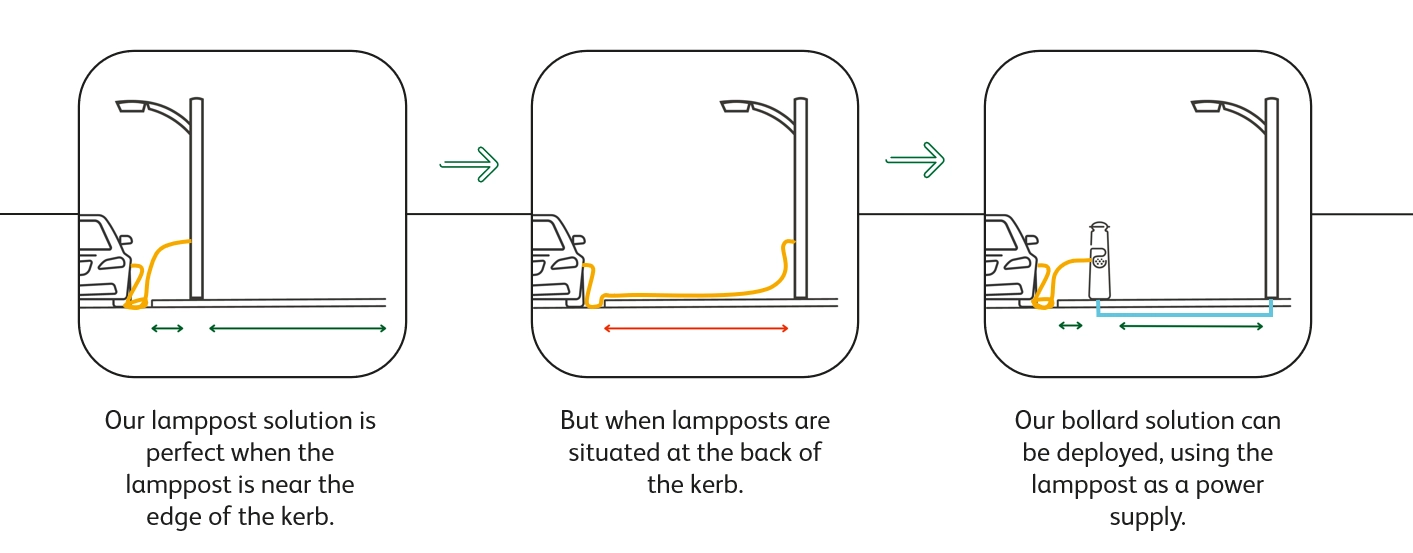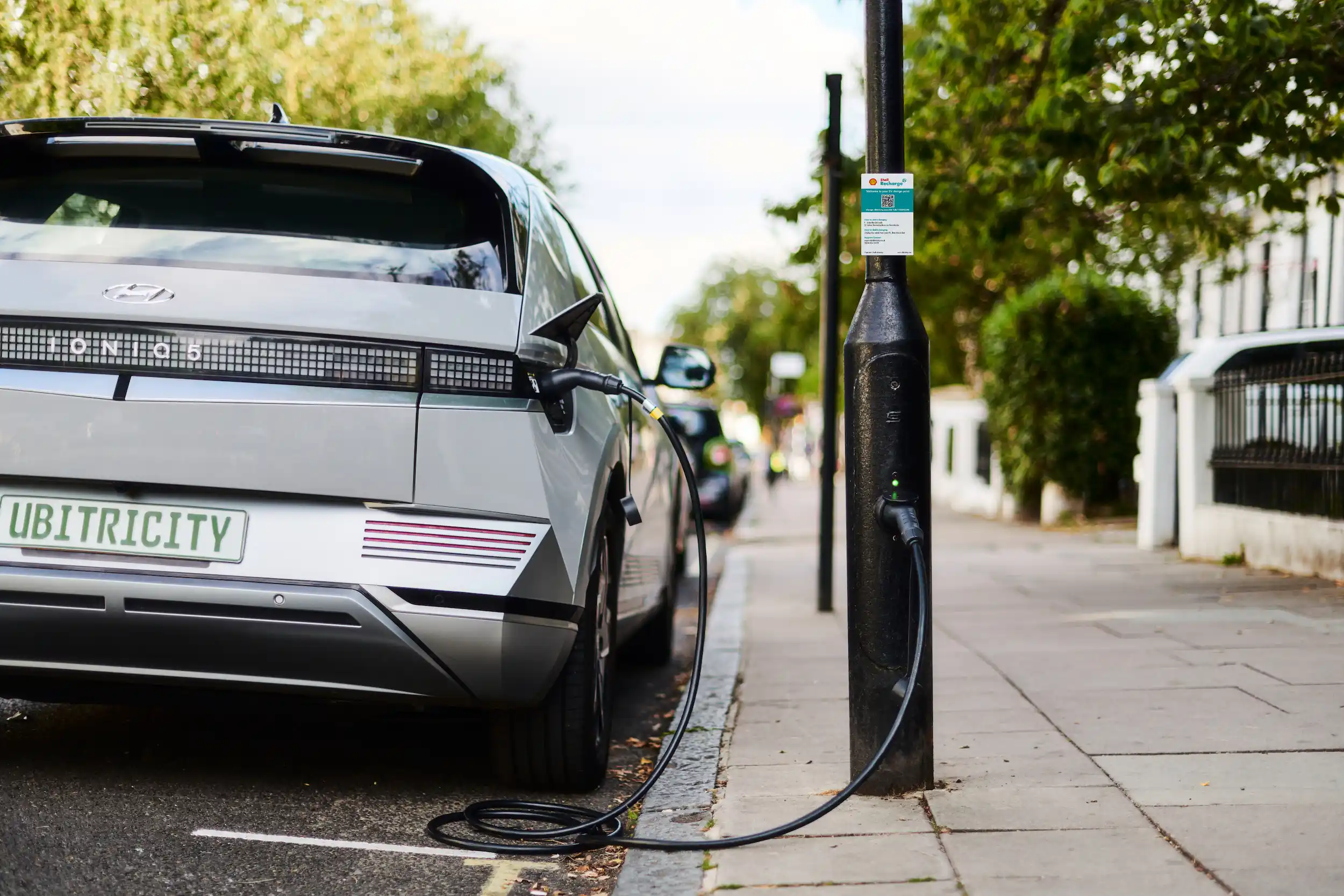When considering charging an Electric Vehicle (EV), you may immediately think of doing so in a garage, on a private driveway using a wall-mounted charger, or plugging into a service station rapid charge point. But an estimated 8 million UK homes do not have a private parking space available with access to their own charger. Without the rollout of convenient, readily available charge points for those without access to off-street parking, a significant proportion of drivers are at risk of being left behind in the transition to EV.
The average car spends most of its time parked, with the majority normally parked for as much as 23 hours a day (1). In front of the workplace, at the supermarket, in a car park, outside friends’ homes or even at home, cars are parked creating the perfect opportunity for users to charge – the question is how to put in place the infrastructure required in as many of these areas as possible.
This is where lamppost charging comes in. Quick and easy to install on residential streets, lamppost charging offers several advantages; the low voltage energy supply can extend the life of the car battery, the chargers can quickly and cheaply be rolled out at scale generating revenue for councils and local authorities and, most importantly, they provide easy and convenient charging close to drivers’ homes.
As EVs become increasingly popular with UK drivers, the need for accessible and convenient charging infrastructure has grown. For drivers without access to off-street parking, on-street charging infrastructure is vital. To provide this, deploying EV charge points within existing street furniture such as lampposts is a readily available solution that can make use of assets councils and local authorities already have at hand.
Contrary to popular belief, lamppost EV charging is not exclusive to dense urban areas such as London. Across the UK, in urban and rural areas alike, lampposts offer a readily available asset that local authorities can use to support EV charging. Leveraging physical hardware and existing power, councils and local authorities can swiftly and cost-effectively use them to house EV charge points, expanding their networks, enhancing accessibility for EV owners, and advancing on the journey to carbon neutrality.
ubitricity has built the UK’s largest network of lamppost and bollard charge points that are integrated into existing street infrastructure and use innovative solutions to keep footpaths clear of trailing wires, providing a low-cost, near home charging option for EV drivers that is well-suited to areas with long dwell times or overnight charging.

A solution to rapidly create EV Charging Networks
Integrating charging infrastructure within existing street furniture like lampposts addresses the growing need to provide charging options for drivers who lack access to private driveways or garages for home charging. By providing lamppost charging, councils can ensure that EV owners have convenient access to charging close to their homes, promoting the adoption of electric vehicles, and reducing range and charging anxieties for owners without access to private charging. With lampposts being almost ubiquitous throughout the country, and already under the control of councils and local authorities, they also offer a huge range of locations to deploy charging infrastructure – and the most convenient locations can be chosen collaboratively with feedback from residents.
With conversion taking as little as three hours, installing charge points in existing lampposts has minimal impact on existing infrastructure and streetscape. Unlike traditional charging stations which require dedicated parking spaces or designated areas, installing charge points in lampposts integrates seamlessly into the surrounding environment, using existing parking spaces, preserving street space, and minimising disruption to pedestrians and traffic flow.
Not just for cities
Lamppost charging offers a scalable solution that can be implemented across diverse environments. Whether in dense urban, suburban, or even rural areas – lampposts provide a versatile platform for installing charging infrastructure that can massively enhance the convenience of charging and cater to the needs of a broad spectrum of drivers. While rural areas often face unique challenges in terms of charging accessibility, lamppost charging addresses these concerns effectively, providing charging infrastructure in areas often overlooked by standalone charge point deployers.
Lamppost positioning doesn’t have to limit councils from using lamppost charging. Where lampposts are positioned at the back of pavements, and trailing cables to the kerb side may obstruct pedestrian pathways, satellite bollards can be used. These standalone charging units can be strategically placed at the front of the kerb with cables attaching to cars directly at the roadside, utilising power from the nearby lamppost while ensuring that pavements remain unobstructed, facilitating safe passage for pedestrians.
To maximise the growth of lamppost-based charging, well-defined and experience-proven processes have been developed to support councils; from discussions about funding, site survey and selection, and planning applications, to installation and ongoing maintenance. Using these established frameworks, transport and local authorities can work with vendors to streamline the deployment of lamppost charging with confidence. At ubitricity our standard offer incorporates hardware, software planning and maintenance to ensure all our customers have an easy roll-out that fits the needs of their residents.
20-25 x 50 kW
single rapid
charge points
(own costs).
OR
60-75 x 7-22 kW
dual fast
charge points
(own costs).
OR
700-800 x 5 kW
single lamppost
charge points
(own costs).

Conclusion
It’s clear that the lamppost has huge potential to meet many of the challenges raised by lack of access to, and shortfalls in, EV charging today. Lamppost networks are vast in the UK, with more than 6.5 million across the country, they are situated in many of the key locations where charging is needed, and already have direct access to the power grid. Lampposts offer the potential to support the quick and cost-effective rollout of EV charging infrastructure and, with the right approach and support mechanisms in place, councils and local authorities have the opportunity to unlock this potential and drive forward the rise of sustainable transportation for their residents.
Do you need more help with the rollout of your EV charging infrastructure? Get in touch with our team and we’ll be happy to answer all your questions and guide you to deliver the best infrastructure for your residents.
References

